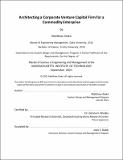Architecting a Corporate Venture Capital Firm for a Commodity Enterprise
Author(s)
Kieke, Matthew
DownloadThesis PDF (12.67Mb)
Advisor
Rhodes, Donna H.
Terms of use
Metadata
Show full item recordAbstract
Since commodity prices can be impacted by external factors, commodity enterprises have historically competed on their cost per unit of production. However, changes within the ecosystem for commodity enterprises are impacting the competitive landscape, leading to a need for enterprise transformation. These ecosystem changes include a growing focus on an enterprise’s environmental impact and a reduction in the barriers of entry due to the growing ease of technology access. Enhanced innovation can assist the enterprise in adapting to this changing ecosystem. This research explores and evaluates both the changing ecosystem and alternative models for enhancing an enterprise’s innovation.
Two innovation models exist: closed and open innovation. Commodity enterprises have historically leaned on closed innovation, yet this reliance has resulted in an enterprise not well equipped to manage a changing ecosystem. Corporate Venture Capital has been a form of open innovation leveraged by enterprises since the early 1950s. These Corporate Venture Capital (CVC) firms can be architected to deliver strategic value, financial value, or a combination of both strategic and financial value. For a commodity enterprise looking to enhance innovation, the CVC firm would pursue a strategic objective. However, there exists limited consensus on how best to architect a CVC firm to pursue a strategic objective, and challenges exist that may naturally lead to a CVC firm focusing on a financial objective.
In this research, the ARIES framework, a systems architecture and engineering framework used for the design and implementation of a transformed enterprise, is used to evaluate the optimal architecture for a CVC firm that is aiming to enhance a commodity enterprise’s innovation. This research analyzes not only the stakeholders of the CVC firm, but also evaluates an envisioned future for the CVC firm, identifies the critical architectural decisions, develops alternative concept architectures, and ultimately evaluates each alternative. Through this evaluation, a hybrid CVC firm containing two separate investment funds is proposed as the preferred concept architecture. This research also proposes a roadmap for the implementation of this new CVC firm architecture, ensuring that the resources and momentum required for a successful launch are in place.
Date issued
2021-09Department
System Design and Management Program.Publisher
Massachusetts Institute of Technology